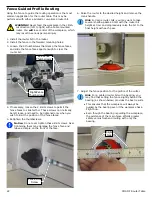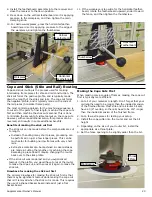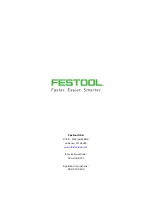
Supplemental Owner’s Manual
21
Freehand Routing with a Piloted Bit
A piloted router bit has a bearing above or below the cut-
ter that guides the cut based on the existing edge of the
workpiece or from the edge of an attached template. The
most common type is a decorative profile bit (shown below)
that forms a decorative edge on the workpiece.
Use this setup for curved workpieces and piloted router bits
only
. For straight workpieces, it is recommended to use the
standard fence even though the router bit is piloted. See
“Fence Guided Profile Routing”
on page 22
WARNING!
Use extreme caution when routing a
profile in curved pieces to ensure the workpiece is
never moved in the climb-cut direction. You
will
lose control of the workpiece, which may result in
serious personal injury.
1. If the standard fence is installed, remove it.
2.
Install the router bit in the router.
3. Raise the router to the desired height and remove the
crank handle.
4. Install the curved guard fence to the table and
tighten all 4 mounting thumbscrews, including the tall
thumbscrew.
Curved Guard
Mounting Holes
5. Loosen the 2 hand guard thumbscrews, and slide the
clear hand guard off the curved guard fence.
6.
Loosen the start finger thumbscrew.
Hand Guard
Thumbscrews
Mounting
Thumbscrews
Start Finger
Thumbscrew
7. Slide the start finger in or out until it is almost tangent
with the pilot bearing. (See inset photo below.)
►
Too close, and it can interfere with the rest of your
routing.
►
Too far, and it can slip behind the pilot bearing.
8. Raise the start finger so it touches the pilot bearing, and
is above the router bit’s cutters.
9. Tighten the start finger thumbscrew.
Start
Finger
Pilot
Bearing
Almost
Tangent
10.
Replace the hand guard and set the height to be slightly
above the workpiece.
11.
Connect the dust collection to the port on the back of
the curved guard fence.
When routing the workpiece, use the start finger to guide
the workpiece into the cutter. This prevents the workpiece
from grabbing, and passing behind the cutter.




















